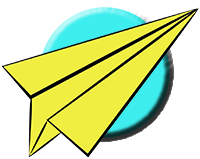Falcon Canard Wing Paper Airplane
Falcon Canard Wing Paper Airplane
Instructions
1. Start with a letter size sheet of paper. Fold the paper exactly in half along the short edge. Unfold after the crease has been made.
2. Fold the upper left point over so it hits the point on the right edge of the paper formed by the existing horizontal crease.
3. Unfold the previously folded flap. Fold the upper right point over so it hits the point on the left edge of the paper formed by the existing horizontal crease.
4. Completely unfold the paper and lay it flat on the working surface.
5. Fold the paper exactly in half along the long edge. Unfold after the crease has been made.
6. Pop the left and right sides up, bringing them in and down towards the center of the paper. When folded correctly, a new flap is formed sticking straight up from the paper’s base and two new creases are formed where the new flap hits the base of the paper at the center line.
7. Split the layers of the flaps apart bringing the points at the flap tips down towards the edges of the paper. Bring the top point, where the flaps meet, straight down and press the whole fold flat.
8. Fold the point at the tip of the nose down so it hits the center line crease. A new crease should be formed along the existing line between the two layers of paper.
9. Flip the paper over so the flaps are underneath.
10. Fold the plane exactly in half along the existing center line crease. Be sure to line up the wine flaps for good balance.
11. Flip the plane over so the wing flaps are pointing up and the nose is to the left.
12. Fold the top point of the upper triangle down over to the right. The dimensions of this fold are not too important but the newly created flap should not be too large.
13. Unfold the flap just created.
14. Pop open the two layers of the small triangle and bring the point at the tip over and down. Two new creases should be formed when the fold is pressed flat.
15. Fold the left point on the small triangle over to the right and down to cover the other triangle of similar size and shape.
16. Flip the paper over and rotate it around so the pointed tip is down. Repeat same steps for other side.
17. Fold the point on the tip up so the newly created crease matches the crease on the other side. Unfold after the crease has been made.
18. Pop open the two layers of the small triangle and bring the point at the tip over and down. Two new creases should be formed when the fold is pressed flat.
19. Fold the point on the small triangle over and down to cover the other triangle of similar size and shape. Note, both sides should now match in size and shape.
20. Rotate the plane around so the wing flaps are up and the nose is to the right.
21. Make a crease for the first wing flap. The right point of the crease should be about one finger in width up from the bottom edge of the fuselage and the left point should be about two finger widths from the bottom.
22. Flip the plane over so the first wing flap is underneath and the nose points to the right.
23. Make a crease for the second wing flap. Be sure to line up the wing flaps for good balance
24. Open up the wing flaps and adjust the wing angles so they are even. Set the dihedral angle flat or slightly up. A down dihedral will cause this craft to fly upside down.
THE THROW Launch gently at a slight up angle. This plane can loop or go long distances depending on the trim. WIth flat wings and just a touch of up elevator, the flight path is long and straight. Lots of up elevator will cause looping. Changing the front winglets causes unpredictable flights.
